Castrating Children in the Service of Male Sexuality
Men's Fetishistic Practices Behind ‘Gender Dysphoria’
“Castration anxiety is easily mistaken for the fear that one will be castrated. In fact, it is the fear that one, being castrated, will like it. The threat, in other words, is not that you will lose power, but that you won’t actually want power, after all. Too often, we imagine powerlessness as the suppression of desire by some external force (maybe someone else’s desire), and we forget that desire, in itself, is often, if not always, an experience of powerlessness. Most desire is nonconsensual, most desires aren’t desired.”
— Andrea Long Chu,
trans-identifying male
Did Sissy Porn Make Me Trans?
Eunuch Cults
Ritual castration dates back thousands of years and can be observed throughout cultures around the world. Eunuchs existed in China 4,000 years ago, were imperial servants 3,000 years ago, and were common as civil servants by the time of the Qin dynasty. Eunuch singers are known to have existed from the early Byzantine Empire, and Italy famously castrated young boys to preserve a feminine singing voice. At the height of Italy’s fascination with the castrati, in the 1720s and 1730s, it has been estimated that upwards of 4,000 boys were castrated annually. The hijras of India, now often referred to in Western media as trans women, traditionally underwent not only castration but also participated in prostitution, a practice that continues to this day.
The Skoptsy
Castration also figured in a number of religious cults. During the late 18th century, for instance, a religious sect emerged in Russia that preached self-mutilation, particularly of primary and secondary sex characteristics. The Skoptsy, as they were called, could be compared to Orthodox Christians: they believed in saints, heaven and hell, and that Jesus Christ died on the cross. Unlike mainstream Christianity, the Skoptsy sect also believed that Christ was castrated.
Skoptsy is a plural of skopets, at the time the Russian term for “castrate”, or what we today might call a eunuch. In accordance with their teachings against sexual desire, Skoptsy men and women underwent ceremonial rituals to remove parts of their sexual organs. This ceremony, called “the seal”, was performed in order to seal their faith in God and live in an imitation of their vision of Jesus Christ. Men who underwent the “minor seal” removed their scrotum and testes; men who chose the “greater seal” also amputated their penis. Similarly, women had their genitals mutilated and their breasts cut off. These dismemberments were called “fiery baptisms,” as they were often performed with red-hot iron rods.
The Biblical passage that inspired the Skoptsy movement came from the Gospel of Matthew, the first book of the New Testament. It states, “There are castrates who were castrated by others and there are castrates who castrated themselves for the Kingdom of God.”
American historian Laura Engelstein, who has written a book on the Skoptsy titled Castration and the Heavenly Kingdom, and in her work refers to claims made about the Skoptsy by Russia's first ethnographer, Nikolai Nadezhdin:
“Nadezhdin in fact did not have a coherent position on this subject. At times he asserted that castration destroyed sexual desire, leaving the Skoptsy deprived of human feeling. But more often he emphasized the paradox that physical incapacity might not hinder, but even enhance, the thirst for physical satisfaction, until desire increased “to the point of savage, frenzied, even bestial rage [neistovstvo].”
In a paper titled From Heresy to Harm: Self-Castrators in the Civic Discourse of Late Tsarist Russia, Engelstein points out that children were recruited into the Skoptic sect:
“There are also many examples of children being put to the knife, sometimes by relatives who adopted the faith. Children also came into contact with the Skoptsy after being hired from their parents to work as apprentices and servants. Once among the sectarians, the children were raised in the spirit of the creed and allegedly kept from contact with their families. When questioned in court, almost all said they had sought castration of their own free will.”
Naturally, Skoptsy men, having participated in genital self-mutilation, were rendered unable to reproduce. It was necessary for the cult to reach out to children in order to grow their own numbers.
Engelstein explains that this was made possible by the fact that “the appearance of virtue among the Skoptsy aroused the peasants’ admiration”, and that their “repetitious recitations… exerted a powerful force” that created a “dependency”.
“The wealthy sectarian community provided shelter for vagrants and runaway criminals, whom they supplied with false papers and new names. To the poor peasant they offered relief from the military draft, escape from serfdom, economic support, and the hope of equality and fellowship. They adopted the children of their own needy relatives, took in orphans, and hired the offspring of impoverished villagers as apprentices.”
In modern times the Skoptsy sect has become the namesake of a male sexual disorder called Skoptic syndrome. The definition of Skoptic syndrome, “persistent preoccupation with castration or penectomy,” is listed as a form of gender dysphoria found under the Diagnostic and Statistical Manual of Mental Disorders (DSM) IV section 302.6: Gender Identity Disorder Not Otherwise Specified.
This definition of gender dysphoria has been obscured by means of “inclusivity”, a term which, in reality, reflects the forced inclusion of women and children into the sadomasochistic sexual proclivities of men in order to normalize either their own fetishes (paraphilias) or the renunciation of an overactive male sex drive.
According to the Wikipedia entry for Skoptic syndrome:
“Some men seek relief from physical or psychological problems, while others derive sexual excitement from the idea of being castrated or otherwise having their genitals mutilated, usually by another person (see masochism and paraphilia). This desire is still present in modern populations, as evidenced in the large membership in message boards on the Internet related to the topic.”
In 1988, John Money published a paper in the Journal of Psychology & Human Sexuality titled, The Skoptic Syndrome: Castration and Genital Self-Mutilation as an Example of Sexual Body-Image Pathology. Money was a psychologist and sexologist well-known for his research on the influence of sexuality on gender identity, and is credited with introducing the term.
In the abstract, Money describes the “practice of becoming a eunuch” as “a renunciation of sex,” and as a “sexual body-image syndrome with degrees of severity: fixation, neurosis, or psychosis.”
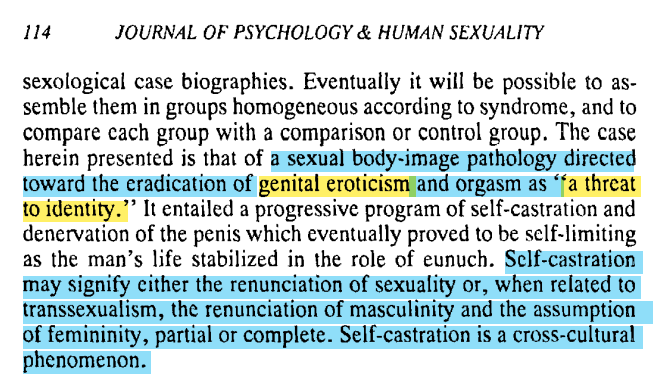
“Self-castration may signify either the renunciation of sexuality or, when related to transsexualism, the renunciation of masculinity and the assumption of femininity, partial or complete. Self-castration is a cross-cultural phenomenon.”
Money goes on to introduce a case study of “a sexual body-image pathology directed toward the eradication of genital eroticism and orgasm as a threat to identity.”
He describes the case study of a man who self-castrated as a result over an overactive libido and the “disgust” he felt with sexuality. He describes the female anatomy as “revolting”, saying that “both the male and female genital orifices were a cause of shame and revulsion.”
“When, at the age of seven, I had the first erection that I can remember, it happened when I was thinking how disgustingly fat one girl in my class at school was. Generally I disliked having an erection and always associated it with some cause of disgust. When I was a little older, I found that older boys were extremely attracted by the female anatomy and liked to ogle pictures of it that I found revolting.”
“In puberty I was horrified to learn that the lusts I found so disconcerting in others had now become my own. I was a heterosexual male, aroused by female nudity, though the old revulsions persisted. The orgasm, which I discovered through masturbation, was immensely pleasurable but utterly shattering and devastating, an annihilation of identity and after it was over, a total desecration of the self-image. I considered my desires a disease and longed for a return to the much more favorable emotional climate I had enjoyed prior to puberty.”
John Money’s books and academic papers were widely published during his day. However, in recent years his work has been scrutinized for what is roundly condemned as the child sexual abuse inflicted on twin brothers David and Brian Reimer. In an attempt to prove that sex was socially constructed, he conducted experiments on the two boys. David Reimer, who had suffered a botched circumcision, was renamed Brenda, and at Money’s behest, was coerced into imitating sex acts with his brother, beginning at the age of six, which Money documented with photographs.
The Hijras
The hijra sect has a long and complex history on the Indian subcontinent, including Pakistan and Bangladesh. Hijra used to be translated in English as “eunuch”, although recently trans activists and academics in the field of queer theory have sought to include them under the broad category of transgender.
According to Wikipedia,
“In India, some Hijras do not define themselves by specific sexual orientation, but rather by renouncing sexuality altogether. Sexual energy is transformed into sacred powers. However, these notions can come in conflict with the practical, which is that hijras are often employed as prostitutes. Furthermore, in India a feminine male who takes a “receptive” role in sex with a man will often identify as a kothi (or the local equivalent term). While kothis are usually distinguished from hijras as a separate gender identity, they often dress as women and act in a feminine manner in public spaces, even using feminine language to refer to themselves and each other. The usual partners of hijras and kothis are men who consider themselves heterosexual as they are the ones who penetrate.
Many get their income from extortion (forced payment by disrupting work/life using demonstrations and interference), performing at ceremonies (toli), begging (dheengna), or prostitution ('raarha')—an occupation of eunuchs also recorded in premodern times.”
Not mentioned in the Wikipedia entry on hijras is their well-documented practice of abducting young boys, castrating them, and selling them in the sex trade.


In July of this year, it was discovered that a group of hijra men organized a sex trafficking racket that involved forcibly castrating young boys and pimping them out in Delhi.
In November 2020, another similar instance was reported. A 14 year-old boy was abducted by a group of trans-identifying men, made to consume alcohol, and forced into prostitution:
“The minor had been brainwashed by a group of transgenders into abandoning his family in Dindigul with the promise of funding his sex-reassignment surgery if he accompanied them to Tiruchi, according to Z. Suji, a transwoman living in Tiruchi, who had approached the Kollidam police for lodging a complaint.
The boy was made to consume alcohol, subjected to sexual assault, and forced into prostitution, said Suji, narrating the story on behalf of the affected minor.”
In September 2021, still another case was discovered wherein a hijra had raped a 14 year-old boy.
The Castrati
The practice of castrating young boys before puberty in order to retain a feminine singing voice first appeared in Italy in the mid-16th century, after the Catholic Church prohibited women from singing in a religious setting.
This exclusion of women from public life created the demand for the castrati. The ban also resulted in the curious case of Teresa Lanti, a woman who kick-started her own singing career by posing as a castrato. Her disguise went so far as to include a false penis. She appears in the writings of Casanova, who mistook her for a castrated male when she was a teenager. (It would appear, then, that the exclusion of women from society can result in men pretending to be women, but also in women pretending to be men.)
By the early 1700s, an estimated 4,000 young men received the operation each year, but only 80 percent of them survived. The average age of a castration subject was eight years old. Prepubescent castration for this purpose continued for centuries but was made illegal in the years leading up to and including 1870.
Castrati were rarely referred to as such, and instead were sometimes called evirato, literally meaning “emasculated.” Castrati tended to be affected by osteoporosis at a young age owing to the decrease in bone mineral density as a result of a lack of sex hormones.
In 2013, the skeleton of Gaspare Pacchierotti, a famous 19th century male mezzo-soprano, was exhumed so that researchers could study the effects that castration had on his body. Pacchierotti was born in 1740 and castrated before he was 12 years old. Pacchierotti was one of the most well-known and sought-after opera singers of his time, beginning from his debut at the age of 19 to retirement at 53. Pacchierotti’s voice was renowned throughout Europe. He traveled to London several times between 1779 and 1791 and even visited Marie Antoniette (1755–1793) in Paris in 1786.
When examining Pacchierotti’s skeleton, researchers discovered severe osteoporosis. Pacchierotti’s lumbar spine had several fractures, and his leg and arm bones had low bone density. These anatomical abnormalities were a direct result of castration's effect on the skeleton.
In an April 2021 article titled “I’m Trans and Puberty Blockers Saved My Life”, Nicole Talbot, a trans-identified male, explains that he began his medical regimen at an early age in order to preserve a soprano singing voice.
“Even from my early toddler days, I wanted the clothes and the toys that were traditionally thought of as being for girls. My trains didn’t crash. They had tea parties,” said Talbot, reiterating the rigid gender stereotypes so often espoused by trans activists.
“I transitioned socially in seventh grade, changed my name to Nicole and began living in the world as a girl in how I dressed and wore my hair. I began auditioning for and landing female roles and making song choices that now reflected my true gender.
But my greatest fear was the voice change that would soon come with puberty. My mom didn’t know what she didn’t know until she learned. And when she learned, then she understood. And once she understood, she became a passionate advocate for me and for transgender kids like me. Because of her, I am pursuing my dreams and I will always be a soprano.”
Regarding the use of drugs euphemistically referred to as “puberty blockers,” the widely-reported refrain tends along the lines of general ignorance about its side effects, or otherwise assertions that their effects are completely reversible.
Yet it has been known for several decades, if not much longer, that castration in male youth results in decreased bone density and increased fractures.
“Although the changes wrought to their physical appearance from castration are well-documented, little is known about the magnitude of the skeletal changes resulting from the loss of sex hormones associated with the procedure. Such a loss of hormones, especially before puberty, affects skeletal growth and development and may result in osteoporosis as well as impacting quality of life.”
“Suppressing puberty in children suffering from gender dysphoria entails several known risks. One is that patients could ‘end with a decreased bone density, which is associated with a high risk of osteoporosis.’”
Puberty Blockers: Chemical Castration
On November 24, 2021, Swedish news outlet Svt Nyheter reported that Ricard Nergårdh, a medical professional at the Karolinska Institute stated that the use of drugs euphemistically labelled “puberty blockers” were in fact a form of “chemical castration”.
One of the drugs most commonly used on children as a “puberty blocker” is given to adult men convicted of sexual offenses to chemically castrate them. This use for Leuprorelin, also known as Lupron, is mentioned only in passing on the Wikipedia page for the drug; however, its use in “transgender hormone therapy” is cited at the beginning of the entry.
“They are also sometimes used as alternatives to antiandrogens like spironolactone and cyproterone acetate for suppressing testosterone production in transgender women.
It is considered a possible treatment for paraphilias. Leuprorelin has been tested as a treatment for reducing sexual urges in pedophiles and other cases of paraphilia.”
According to the Wikipedia page for chemical castration,
“Leuprolide acetate is an LHRH agonist that is most commonly used in chemical castration today. This drug has been observed as having higher rates of success in reducing abnormal sexual urges and fantasies, but is often reserved for those offenders who are at a high risk of reoffending due to the drug's intense effects.”
“Because it can reduce libido, some countries chemically castrate people who are incarcerated for sexual violence.
A handful of states within the United States have legalized chemical castration for people who are incarcerated for sexual violence. It’s usually used as a condition of parole.
It’s not clear that lowering your sex drive is enough to prevent sexually violent offenses. Not every person will completely lose sexual function.”
Chemical castration may also be referred to as “hormone therapy” and can include the ingestion of estrogen.
The first reported attempt of hormonal manipulation to reduce pathological sexual behavior occurred in 1944, when diethylstilbestrol (DES), a synthetic estrogen, was prescribed to lower testosterone levels. Most famously, DES was forcibly prescribed to Alan Turing beginning in 1952 as a punishment for the perceived crime of his homosexuality, which was a punishable offense in the UK at the time. Turing was given only two choices: imprisonment, or chemical castration (“hormone therapy”), ostensibly to reduce his libido. This resulted indirectly in his suicide.
DES was experimentally given to pregnant women from 1940 to 1971, in the incorrect belief that it would reduce the risk of pregnancy complications and miscarriages. Significantly, GnRH agonists were discovered in 1971, and GnRH analogues were introduced for medical use in the 1980s — at the very same time that the horrific effects of DES spurred a wave of lawsuits in the United States. (DES is an agonist of the estrogen receptors, whereas “puberty blockers” are agonists of the gonadotropin releasing hormone.)
In 1971, a report published in the New England Journal of Medicine established a link between DES and vaginal clear cell adenocarcinoma in girls and young women who had been exposed to this drug in utero. Later in the same year, the FDA sent a Drug Bulletin to all U.S. physicians advising against the use of DES in pregnant women.
Even more startling, Abbott Laboratories was identified as a defendant in lawsuits from victims who contracted cancer that resulted in the termination of the use of DES; Abbott Laboratories, renamed Takeda-Abbott Pharmaceuticals, developed GnRH agonist Leuprolide.
There are so many common “uses” for both DES and GnRH agonists that medical research frequently compares the two.
DES was used to treat prostate cancer; Leuprolide is used to treat prostate cancer. DES was used to prevent “tall stature” or “height dysphoria” in growing adolescent girls; Leuprolide is used to treat “precocious puberty” and to halt puberty altogether. DES is rated a Category X drug due to its known toxicity, and was given to pregnant women whose children contracted cancer; Leuprolide is rated Category X, but to this day is given to pregnant women in the surrogacy industry, despite warnings on the drug’s own official website advising against its use during pregnancy. (Incidentally, there is a large amount of anecdotal evidence from women who have been involved in assisted reproductive technology procedures, including egg donation, IVF, and surrogacy, correlating Lupron’s use with cancers of the female reproductive system, yet long-term follow-up research on its effects on women in ART has not been required by the US government.)
DES was used in chemical castration; Leuprorelin is used to castrate convicted sex offenders in many parts of the world today. Yet the efficacy of chemical castration in reducing sexual urges is still disputed, as are the ethics of its implementation in policies surrounding attempts to rehabiliate recidivist sexual abusers.
Castration as a Sadomasochistic Fetish
“A number of men have extreme castration ideations. Many only fantasize about castration; others actualize their fantasies. Physicians need to be aware of males who have strong desires for emasculation without a traditional MtF transsexual identity.”
— A Passion for Castration (2008)
In 2008, a group of researchers from Canada and California collaborated on a research project on the topic of the male castration fetish and published their findings in a paper titled, A Passion for Castration: Characterizing Men Who Are Fascinated with Castration, but Have Not Been Castrated.
Over seven hundred individuals responded to a survey shared on a eunuch fetish site, eunuch.org, describing their reasons for their “ambition toward eunuchdom”. The men involved in the questionnaire displayed “a greater desire to reduce libido, change their genital appearance, transition out of male, and prevent sexually offensive behavior.”
According to the research,
“When asked about the origin of their interest in castration, respondents could select more than one factor. The majority (52%) of wannabes selected sexual fantasy as their origin of interest in castration. The second most common origin of interest (27%) reported was a desire to reduce libido.
Several respondents wrote about witnessing animal castration at a very young age. ‘As a boy growing up on a farm, I was aroused by watching the horses gelded.’ ‘When I was 5 I witnessed my first hog castration. It excited me as nothing else ever had watching it.’
Respondents indicated a desire to ‘finally calm down and think of other things than sex.’ One respondent expressed the hope that, ‘I will be freed from overwhelming sexual desire. The belief that I will be able to relate to women without my sex drive getting in the way.’
For some, castration was a very important first step toward an MtF transition. Some claim to have been properly diagnosed with a GID by professionals, but others were self-diagnosed. As MtF transsexuals, they sought to rid their bodies of unwanted testosterone, with or without supplemental estrogen to further their transition.
One respondent wrote of his desire for ‘becoming ‘it’—a submissive guy without sex drive.’ More common was the slave metaphor, ‘as a slave it would allow a greater focus on serving the pleasure of the Master.’”

The respondents to the survey were part of a community of fetishists that interact with each other on forums in The Eunuch Archive where information about gender identity, eunuchdom, and MTF transitioning is frequently shared. The website has been live since at least 1998, which is the earliest entry documented on the internet archive.
***Only hours before I published this article, the World Professional Association for Transgender Health (WPATH) released their updated Standards of Care, which include eunuchs as part of the broad definition of transgender.


The WPATH linked through to The Eunuch Archive in their document, despite the disturbing erotica posted on the site, which includes violent castration fantasies that involve children.***

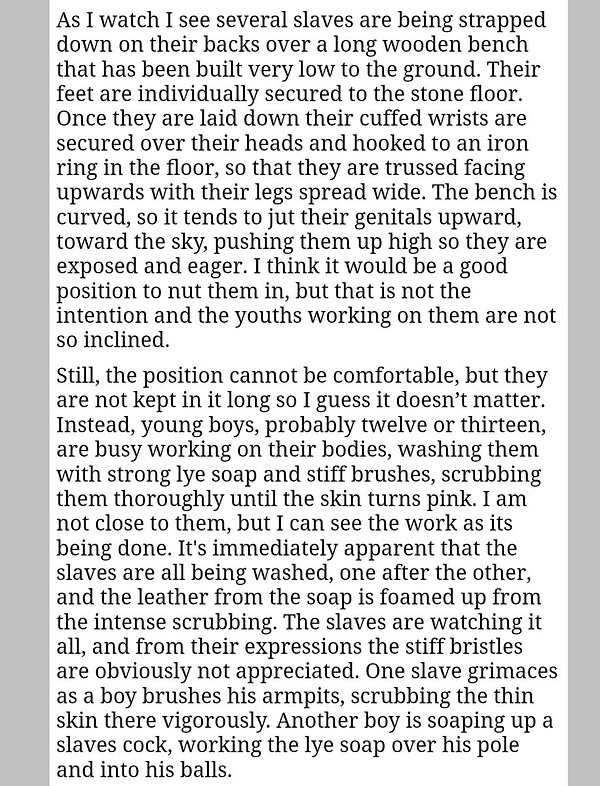
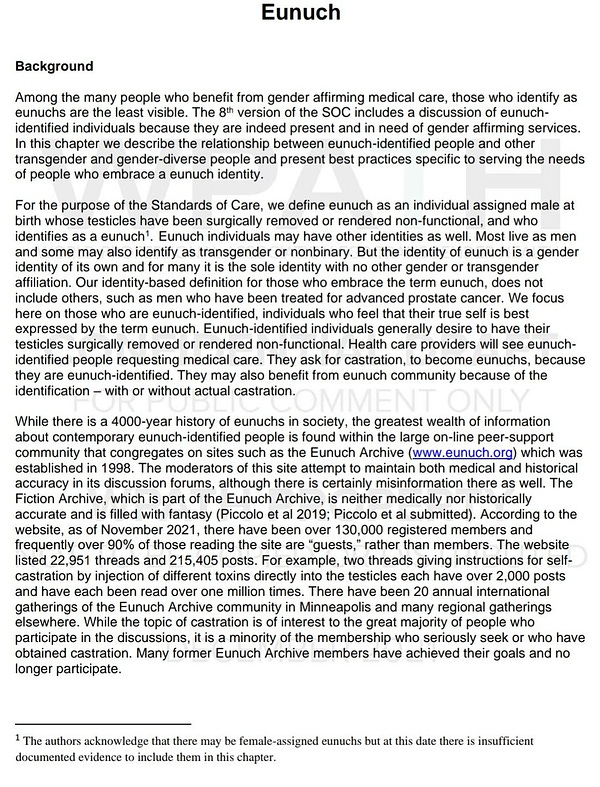

Erotica posted to The Eunuch Archive is extremely violent and disturbing and includes fantasies of castrating children.
In a thread posted to The Eunuch Archive under the group, Gay, Bisexual, & TG Room titled, “Small Breasts are Beautiful,” one commenter (named notsomanly) said, “I’m thrilled to know that, given the appropriate hormone therapy, my breasts could lactate and I too could experience nursing. There are quite a few people born male who find pleasure in maintaining lactating breasts. It's considered a kink by some, but for me it would probably be a spiritual experience that would confirm my feminine identity.”
Another used (adele75t) said, “I have lactated recently and each time it was quite euphoric. Just a few drops is all I can squeeze out but I have been taking domperidone for that exact purpose.”
The Eunuch Archive also hosts a group called “Transgender Discussion Forum” where participants discuss a range of related topics, whether their desire to be castrated or their desire to “become” a woman based on objectifying stereotypes of femininity. Some users boast of growing breasts, regrowing their hair, or acquiring “girl skin”, by which they mean a softer and more youthful-looking complexion.
In a thread titled “Celebrating My Female Identity”, one netizen states:
“I am, in fact, a woman born into a man’s body. From a lifetime of discomfort with male sexuality, to hating my body hair, to chemical castration, to taking female hormones, I’ve steadily become happier and feel more like my genuine self.
Developing breasts was the clincher. As a T-driven male, breasts were sex objects. Now I see them purely as the beautiful, life-giving feminine features they are. I would have loved to have the experience of becoming impregnated, enjoying my body become as beautiful as a woman can ever be while carrying the fetus to term and nursing it from my own breasts. I can only fantasize about all this, but I can enjoy just being a woman.”
Sissification
Sissification falls under the pornography category of “forced feminization”, wherein men pretend to be unwilling participants in sexual activities that involve everything from dressing in women’s lingerie to injecting estrogen. There are multiple tube sites dedicated to this type of pornography, and the practices are widely discussed in forums such as Reddit and 4Chan.
Chemical castration and the use of “chastity cages” are predominant features within this type of pornography and written erotica. In regards to chastity cages, men on social media and in forums online advertise challenges which gamify the amount of time they promise to spend “locked up”.

In addition, men in these forums encourage each other to perform their fetishes publicly. They may begin by wearing women’s underwear in public, experiencing arousal from their secret exhibitionism, or, begin “feminizing” their bodies by means of ingesting estrogen.
The website Sissify.com, a subscription-based platform that offers BDSM erotica on the theme of “forced feminization” — a pornography genre centered around sexualizing the humiliation of being turned into a woman — has been operating for over two decades. In addition to offering information about hormones and orchiectomies (castration of one or both testicles), the site also features a gallery of photos of men in lingerie and fetish gear submitted by paid subscribers.
The site refers to feminizing hormones such as estrogen as “girl juice” and sexualizes their injection or ingestion, saying: “Welcome to the super sexy, silky, and complex world of hormone replacement therapy.”
Comments on the page reflect the fetishistic element involved in the ingestion of female hormones by men who use the site:
“My Dearest Mistress,
This slut is seeing results thanks to her girl juice. My arms are slender and hairless and don’t need to be shaved, as well as my legs. Those breasts of mine are getting bigger and the nipples more sensitive. This Sissy Maid is shedding tears of girlish gratefulness. I want to thank so much the house for giving this pathetic panty slave the pink and frilly roadmap to becoming a girl. Most importantly, my brain has been rewired to be maternal, nurturing, and caring. I am more intuitive and docile. Female hormones and phytoestrogens seem to be doing the trick for this girl. Kicking maleness to the curb, this girl feels so liberated. Thank you again.”
“This sissy slave has had good results taking pueraria mirifica, obtainable from Missolima Ltd. Take 6 per day and watch your boobs grows!”
“This sissy has been considering hormones for quite some time. Sissy Misti doesn’t have the best complexion, too many years running around as a lost boy. Will hormones help soften a girl’s face?”
In a section of the site describing surgical castration, or orchiectomies, the overlap between eunuchdom, religion, and paraphilias is described:
“Some men seek this procedure in order to remove what they consider uncomfortable, uncontrollable or dysfunctional sexual urges. Others may seek it in order to fulfill a fetish or fantasy. The most common reason for control of sexuality is as part of rehabilitation for sex offenders.
There are also eunuchs, which get castrated for religious or alternative gender identities.”
One purported benefit of removal of the testicles is that by reducing testosterone production overall, men seeking to “feminize” their bodies can spare their liver and kidneys by decreasing their hormone intake.
This fetish is discussed widely across transgender forums and social media.
In the subreddit r/AskTransgender, one user commented: “I [would] rather not have to take spiro anymore due to side effects and would love to be able to balance my levels much easier. I’ve also heard after castration transwomen tend to see better faster results overall.”
Another asks for advice regarding their castration fetish, saying, “Sorting out what my castration fetish means for my MTF trans status. I’m turned on by the thought of being castrated. This makes me worry I’m pursuing bottom surgery just because I’m some sort of weird, self-loathing male.”
The Role of Pornography
Robert Stoller, an American psychiatrist and psychoanalyst who studied homosexuality, transexuality and intersexuality, was inspired by the work of New Zealand sexologist John Money when he coined the expression “gender identity” in his 1968 book Sex and Gender.
Money, mentioned previously for his paper on Skoptic syndrome and his sexual experiments on children, recommended showing pornography to children in order to help them understand their “gender identity”. In his 1975 book Sexual Signatures, Money said:
“The firmest possible foundations for gender schemas are the differences between male and female genitals and reproductive behavior, a foundation our culture strives mightily to withhold from children. All young primates explore their own and each others’ genitals, masturbate, and play at thrusting movements and copulation — and includes human children, everywhere, as well as subhuman primates. The only thing wrong about these activities is not to enjoy them.
Explicit sexual pictures… can and should be used as a part of a child’s sex education. The best time to introduce such pictures is before a child’s biological clock has signaled the start of puberty. Prepubertal children are intellectually capable of understanding sex, and their curiosity about life runs high. They will no doubt find these pictures erotically stimulating, but as the novely wears off they will soon settle down and accept the information in the matter-of-fact way they accept information about other facets of adult life.
Sexual intercourse can be safely explained to our children as a game grown-ups play. With a little calm guidance, the experience can be integrated into the child’s sex education and serve to reinforce his or her own gender identity / role.
The sexual organs themselves are active from birth. Babies of both sexes have been known to exercise their bodies and genitals rhythmically so as to achieve spasmodic muscular reactions that resemble sexual climax, and in some cultures it’s customary to stroke an infant’s genitals as a way of soothing distress or lulling the baby to sleep. Evidence that babies normally experience something very like the pleasure and comfort adults derive from sex is not hard to find.
Attempts to define obscenity and pornography are often ludicrous. Pornography will not turn a child into a sex degenerate, a sex maniac, or even a picture freak, nor does pornography broaden the appetites of a deviant at any age… No doubt there are better ways than pornography to satisfy the itch of normal curiosity about sex, but leaving children in a morass of ignorance about a significant aspect of their being is hardly one of them, nor is it any help to them in sorting out gender behavior.”

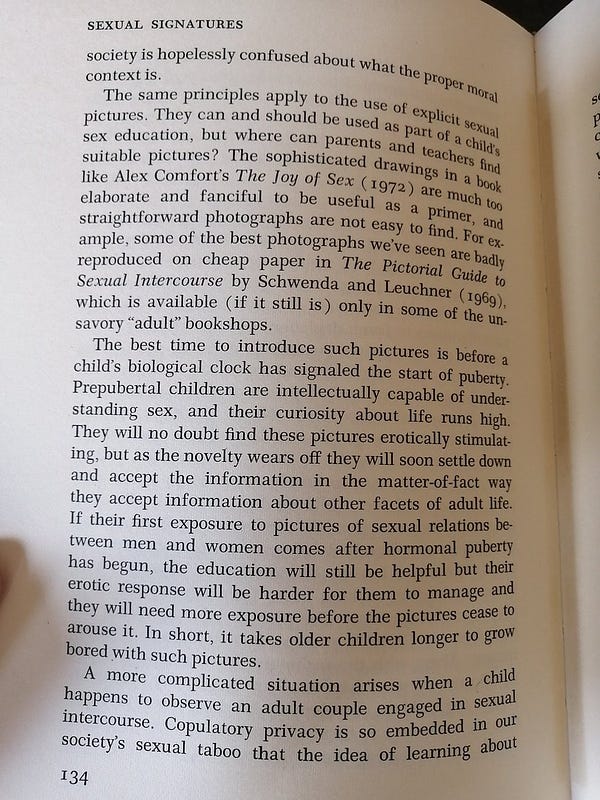
Pornography is currently being used to groom children into gender identity ideology, although it is not clear how often this occurs because there is no modern research available on the phenomenon. Other barriers to understanding this very real crisis include the inaccessibility of discussions taking place on private, data-encrypted platforms such as Discord, WhatsApp, and Telegram.
A search for the supposedly innocuous terms “trans” and “transgender” in Discord’s server directory link immediately to hardcore pornography servers, including those in the catgories BDSM, nudes, kink, femboy, trap, femdom, age play, furry, and slave.

A growing number of parents with children who suddenly claim a transgender identity are speaking up about the infleunce of pornography on their children.
Recently, one such anonymous parent authored an article called “A Trans On-line ‘Friend’ Groomed My Son”, which describes how their 14 year-old son utilized a school-issued laptop to access pornography and to communicate with adults. The son had initially believed himself to be gay, but began to question his gender identity after interacting with these online communities, and later stated that he was a lesbian girl.
“The laptop was chockfull of evidence from his trip to the dark side of the internet, where no child should be wandering. I found the pornographic side of Deviant Art, Tik Tok, YouTube and Reddit. Late at night while we slept, my son had been on these sites and was interacting with adults and older teens in many different subgroups.”
Commenters encouraged the young boy to cut himself and to skip meals in order to lose weight and resemble a girl.
“I also noticed that a few users commented and interacted with my child more than others. These people invited him to private chat rooms and then suggested that they video chat because typing was “too much”. I continued to sift through the computer and was shocked to learn that one of the online friends was a self-identified adult transwoman who offered to coach him and help him accept who he really was.
The ‘friend’ sent what I now know are dysphoria hypnosis recordings to ‘help him relax and sleep’. I listened to this recording and it included mantras about imagining himself as the women he was always meant to be and described engaging in sex acts such as fellatio and being penetrated by a man while visualizing himself as a woman. I have yet to listen to the entire track as I was so disturbed by the content and even more disgusted that an adult sent this to my 14 year old kid.”
The recordings referenced in the article are known as “sissy hypnosis”, and they exist across a range of social media sites, as well as YouTube, SoundCloud, Patreon and Reddit, often with no age verification required. Sissy hypno incorporates audio files that aim to “brainwash” male listeners into believing they are women. Through repeated mantras, sissy hypno content creators claim to turn men into “bimbos” and “f*ck dolls.”
Testimonials abound of men who claim to have begun watching pornography and / or listening to / watching “sissy hypnosis”, then feeling motivated to “transition” by taking hormones.

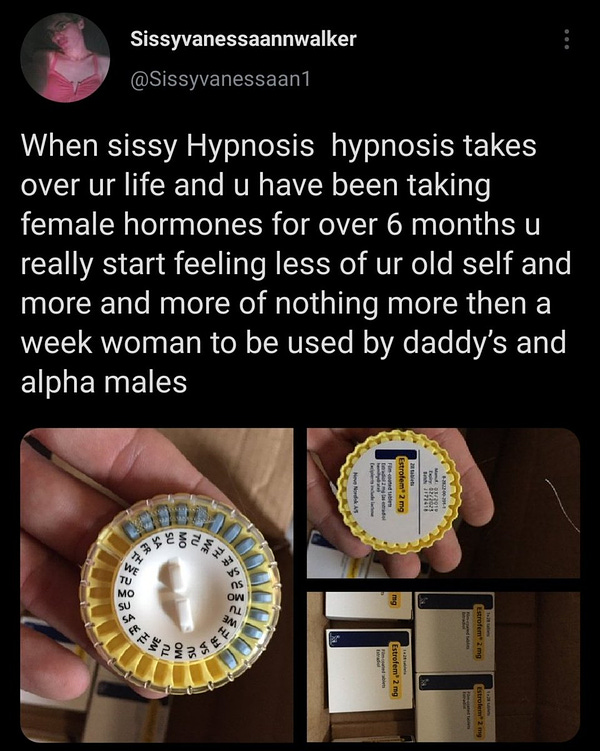
There is also an abundance of anecdotal evidence in forums such as Reddit of men and even teenage boys who say that pornography, specifically forced feminization pornography and sissy hypno, made them feel confused about their gender identity. The subreddit r/TGandSissyRecovery currently has over 10k members who discuss this in detail and provide support for each other. The group has doubled in membership since this time last year, when I wrote about this topic for Feminist Current.

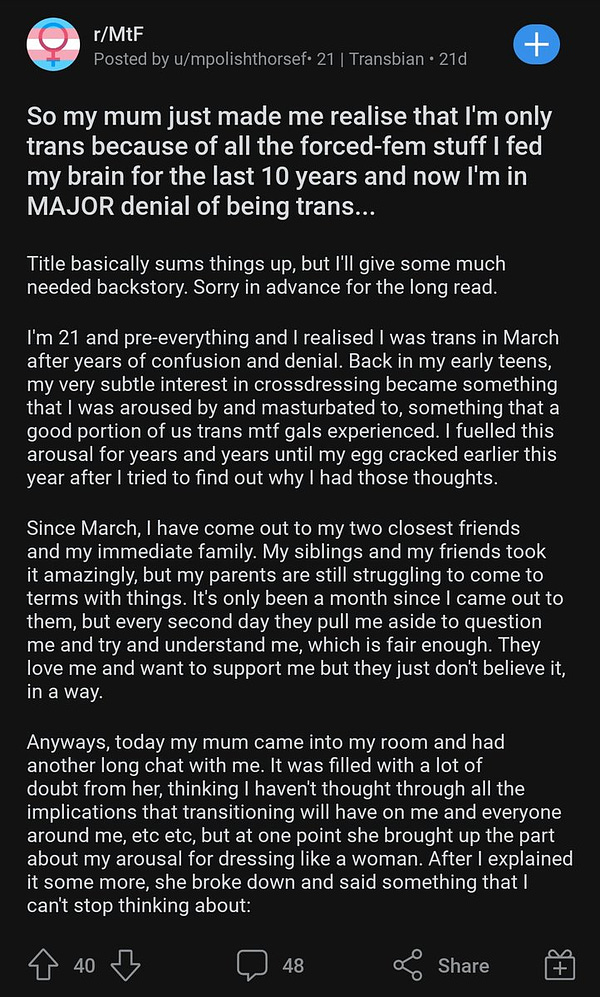
In some instances, young boys are stating that forced feminization pornography contributed to their belief that they are actually girls, trapped in the wrong body.

There is also no shortage of adult men claiming a transgender identity who are creating “sissy captions” with photographs of children stolen from social media. A caption includes a photograph of a woman, girl, or boy in drag, usually highly sexualized and with pornographic text to accompany it, that provides motivation for males to transition. Such men sexualize children, especially the thought of themselves as young girls, or the fantasy of young boys being “transformed” into young girls.


I recently uncovered an app that was available on Google Play which dedicated an entire segment of its erotica to the theme of forcibly transitioning, or “sissifying” young boys. Photographs of underage boys wearing makeup or dresses were used, as were photographs of little girls. One of those girls was Molly Russell, a schoolgirl who committed suicide after viewing violent content on Instagram (her photo has since been removed from the app after her family’s lawyers were made aware of the situation).
Based on this evidence, it is my view that children are being groomed into gender ideology by adults, and often adult men with sexual fetishes. This grooming can happen through various mediums, including seemingly harmless classroom curricula; however, with the exception of the brave parents speaking out, the element of pornography as a grooming mechanism is largely unexplored.


“To be a sissy is always to lose your mind. The technical term for this is bimboification. Captions often instruct viewers to submit themselves to hypnosis, brainwashing, brain-melting, dumbing down, and other techniques for scooping out intelligence.
The gestures most often looped in GIF format almost always register the evacuation of will: wilting faces, trembling legs, eyes rolled back into heads. Even the GIF format itself communicates this, a kind of centrifuge for distilling the femaleness to its barest essentials — an open mouth, an expectant a**hole, blank, blank eyes. Sissy porn did make me trans.”
– Andrea Long Chu, academic, trans-identified male

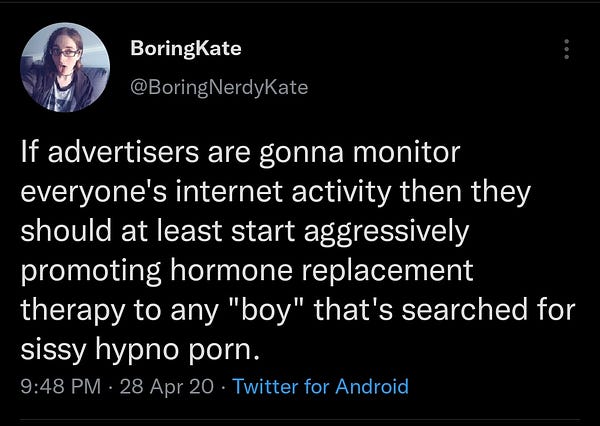
Closing Remarks
Gender ideology represents the literal embodiment of male entitlement to women, and the sexualized power hierarchy that feminists once described as gender, or sex role stereotypes. This eroticization of power and powerlessness has the effect of naturalizing women’s subordinate role in society. When men perform a parody of femininity and claim this farce is what women truly are, they are fundamentally deconstructing women’s humanity, reducing half the human population to a demeaning and objectified fantasy; but crucially, they are redirecting women back to the restrictive roles that afforded them power over the female sex in the first place.
The belief that womanhood can be attained through a combination of desire reframed as devout suffering, alongside the purchasing of products — clothing, cosmetics, surgeries — is, at its core, a belief that women are commodities which men are entitled to possess. It is a belief system that attempts to define women as fetish objects and reduces women to the Freudian castrated male.
As Janice Raymond explained in her 1979 book The Transsexual Empire, the definition of the word “fetish” reveals the connections between religion, objectification, and a sadomasochistic sexuality:
“Webster’s Dictionary defines fetish in several ways: First, as an object believed among a primitive people to have magical power to protect or aid its owner; broadly: a material object regarded with superstitious or extravagant trust or reverence; an object of irrational reverence or obsessive devotion; an object or bodily part whose real or fantasied presence is psychologically necessary for sexual gratification and that is an object of fixation to the extent that it may interfere with complete sexual expression. Second, as a rite or cult of fetish worshipers. Third, fetish is simply defined as fixation.
From these definitions, it is clear that the process of fetishization has two sides: objectification, and what might be referred to as worship in the widest sense. Objectification is largely accomplished by a process of fragmentation. The fetish is the fragmented part taken away from the whole, or better, the fetish is seen to contain the whole. It represents an attempt to grasp the whole. For example, breasts and legs in our society are fetish objects containing the essence of femaleness. Thus the fetish contains and by containing controls.”
In decades past, the overwhelming majority of those claiming to suffer ‘gender dysphoria’, or a strong wish to inhabit the body of the opposite sex, were adult men with transvestic fetishism. These days, gender dysphoria is used broadly to refer not only to a male preoccupation with his status in society and the size or shape of his own genitalia, but to a discomfort with one’s sexed body in general. In this way, the male sexual practices of feminization and castration — whether surgical, chemical, or metaphorical — have been expanded to include women and children.
Feminists had previously initiated a societal conversation about the ways unrealistic beauty standards and objectification led to body image issues. However, now it is taboo to acknowledge that women and girls account for the vast majority of those diagnosed with body dysmorphic disorders, or to suggest that in women and girls, what is called ‘gender dysphoria’ may be a modern rebranding of the self-loathing and self-harm seen in anorexia and cutting.
The reasons that women and girls experience discomfort with their bodies are profoundly different from the ways adult men express their desires to become “sissy sluts”, to “grow boobs” or get “girl skin”, or to otherwise inhabit female bodies for the purpose of arousal at being treated like, and degraded as, a woman. Therefore, I propose that what is really meant by “inclusivity” is the forced integration of women and children into male fetishistic proclivities in order to normalize them. In this, women and children are being treated as collateral damage.


Just as the Skoptsy, the hijra, and those responsible for the castrati actively indoctrinated children into self-mutilation, sometimes by force, so the modern transgender movement tirelessly targets youth. Through children’s books, social media, television programs, celebrities, and influencers, young people are being told that masochism and dissociation are not only to be celebrated, but an expression of identity.

It was necessary for the Skoptsy to alienate children from their families in order to achieve this; similarly, gender ideologues claim that parents are abusing their children when they attempt to protect them from harm. Gender ideology represents a new iteration on the strategies of previous self-harm cults. From the Skoptsy to the Castrati, women and children have long been mutilated to normalize the practices — whether religious, cultural, or sexual — of adult men.
The abuse of children to rationalize a destructive and dangerous form of sadomasochistic fetishism is evil. It is evil to mutilate and castrate children in the service of disappearing male sexual practices and politics. It is evil to instill anxiety, distress, and self-loathing, whether through homophobia or strict stereotypes, only to sell the ‘cure’ for body dysmorphia in the form of sterilizing pharmaceuticals and mutilating surgeries.





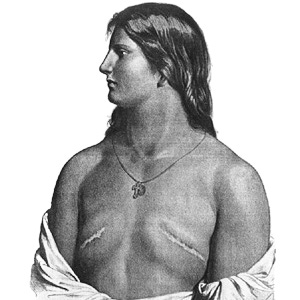
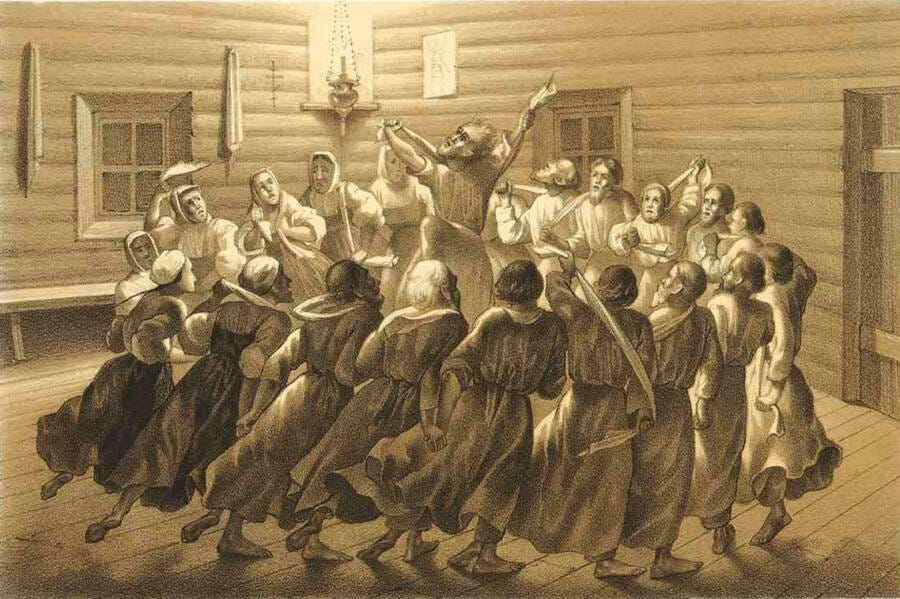
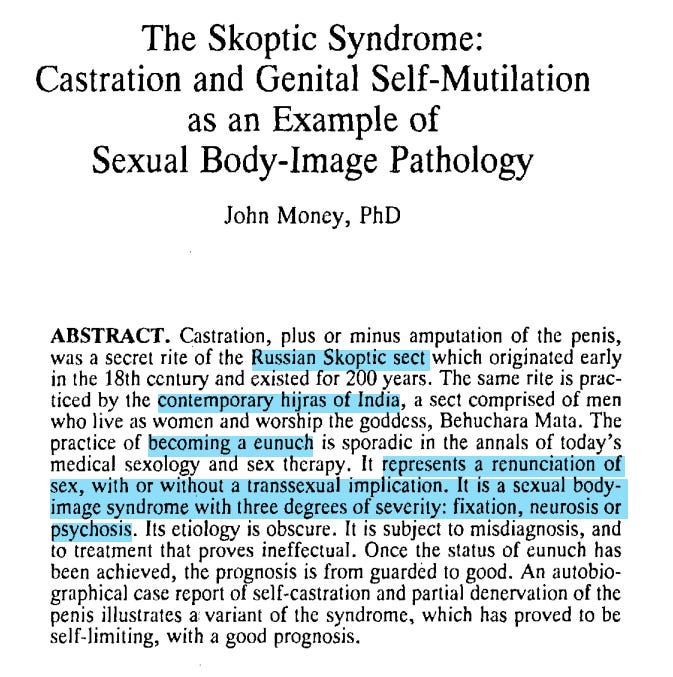
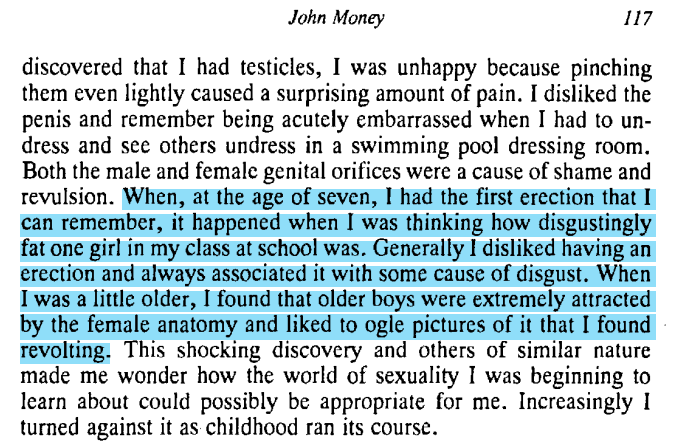
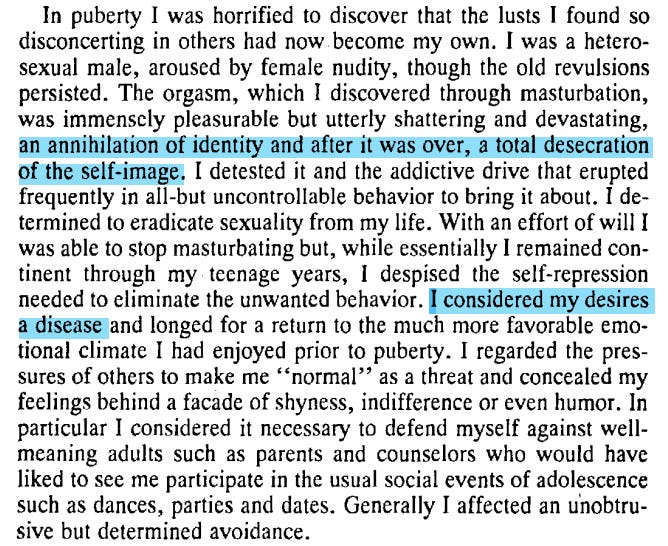






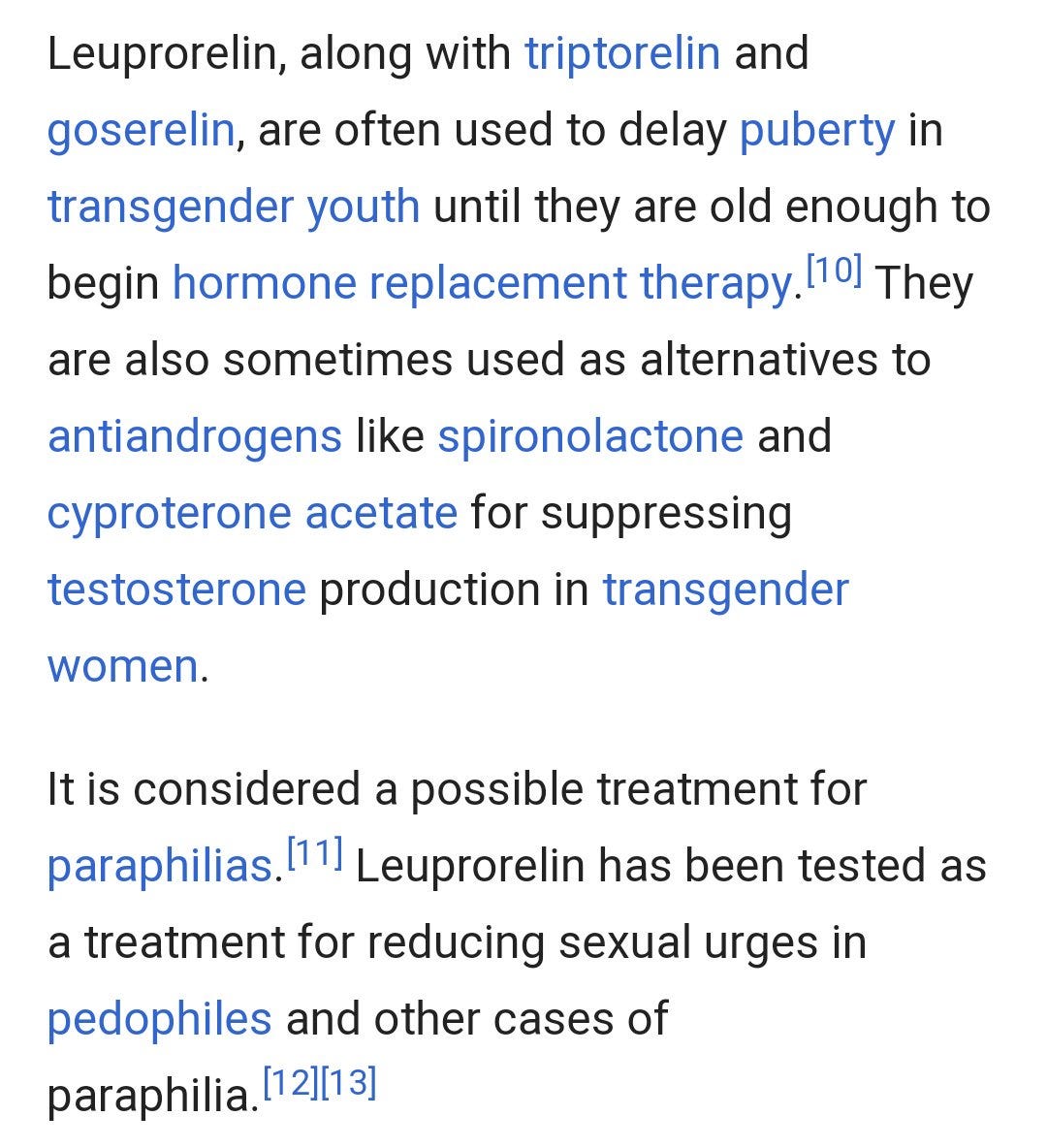
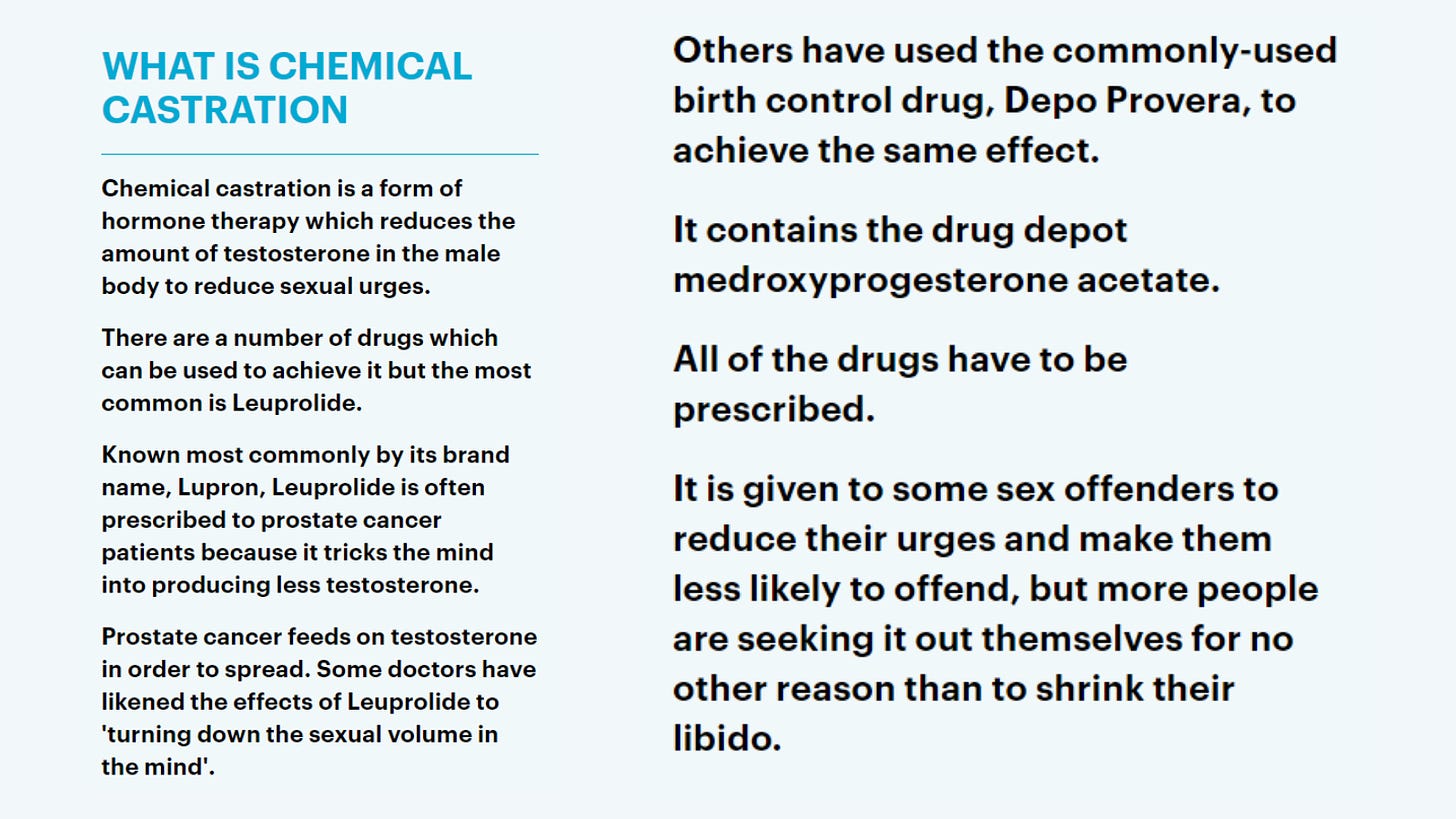

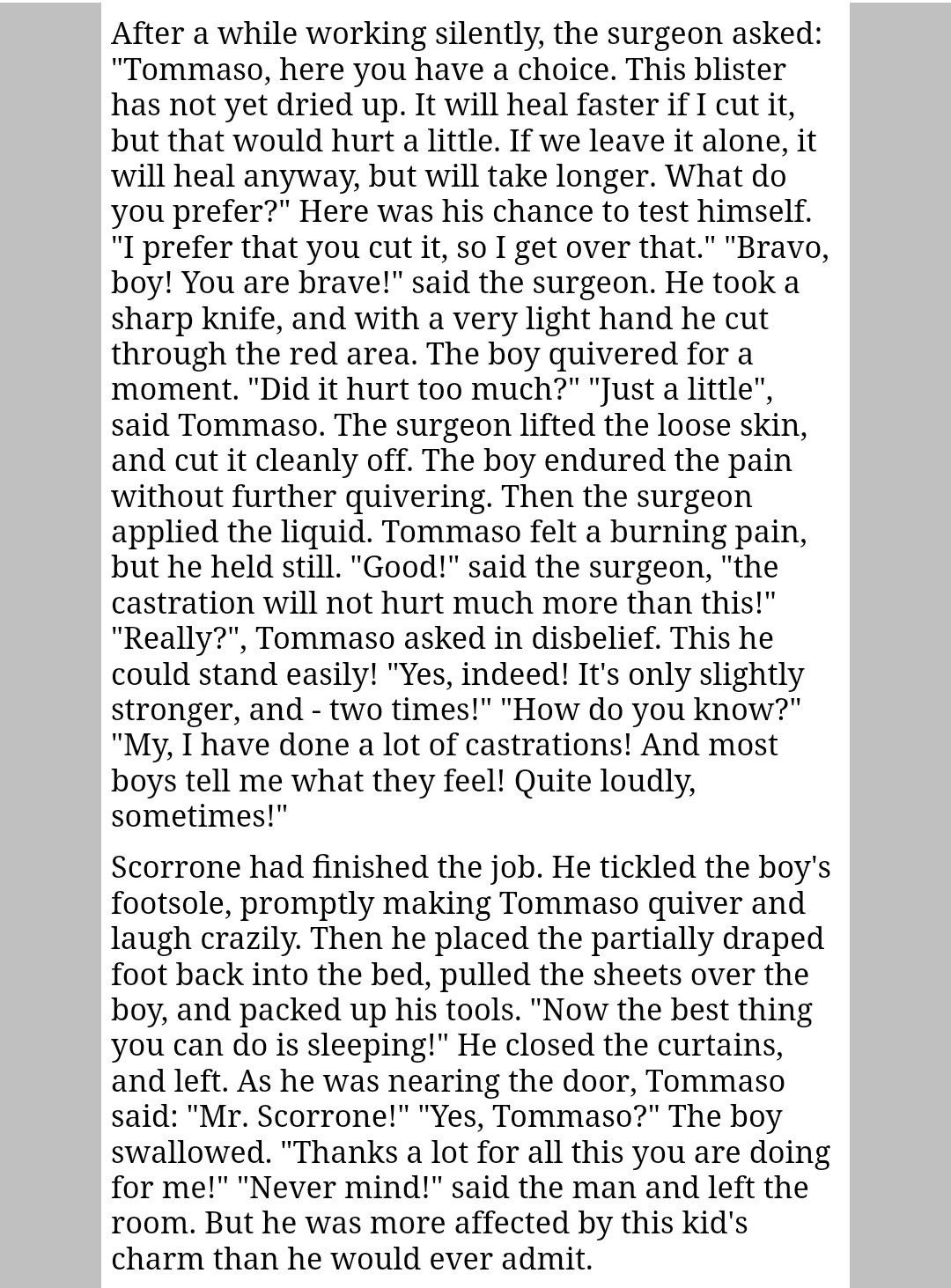



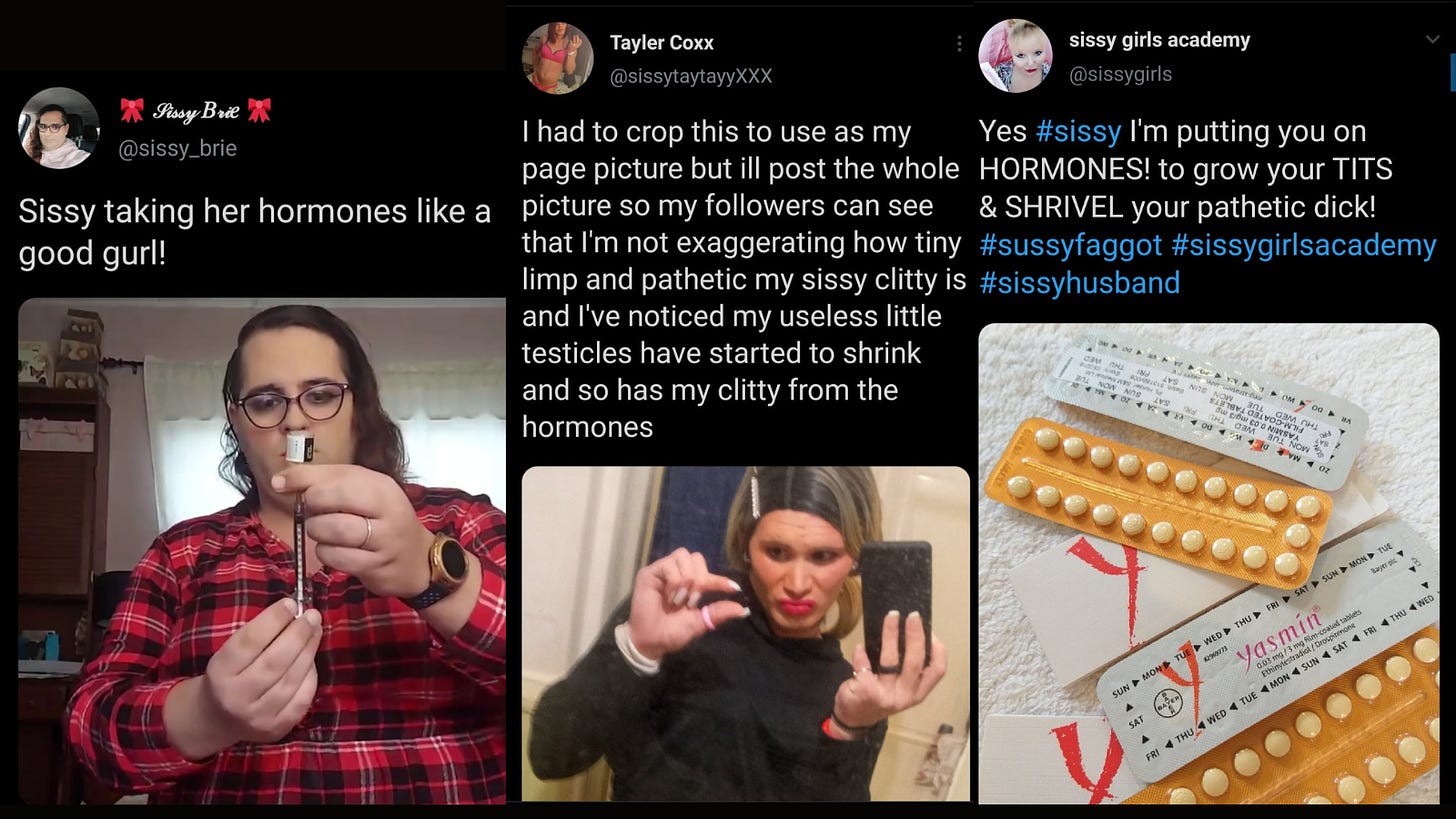

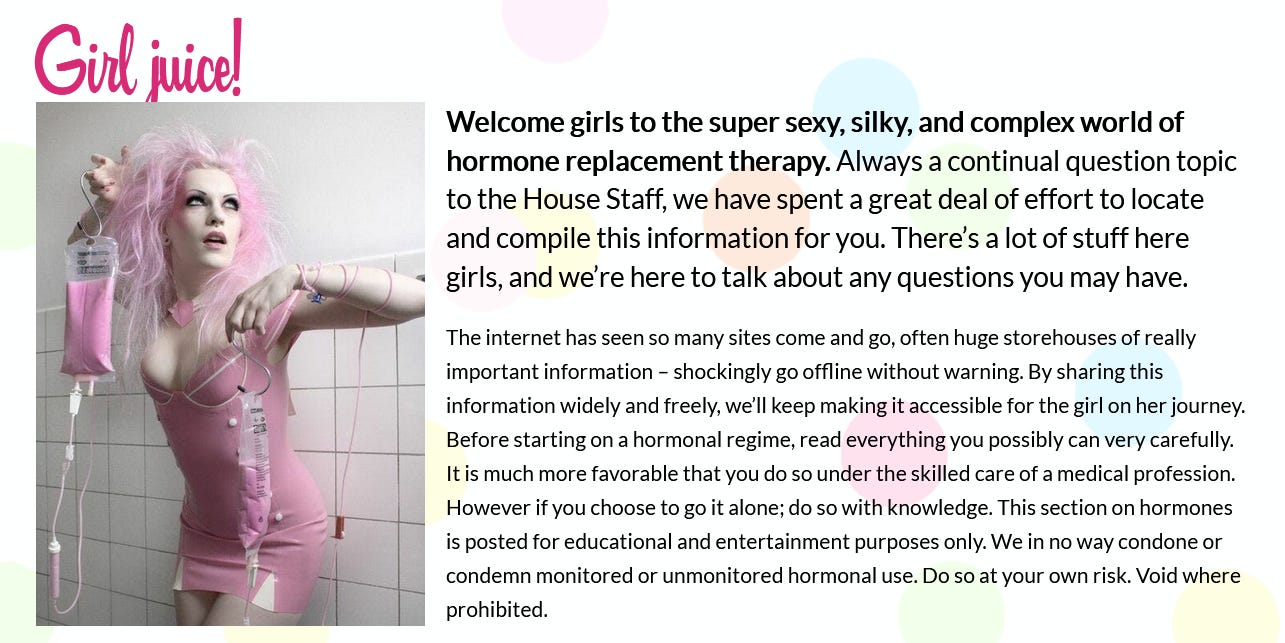

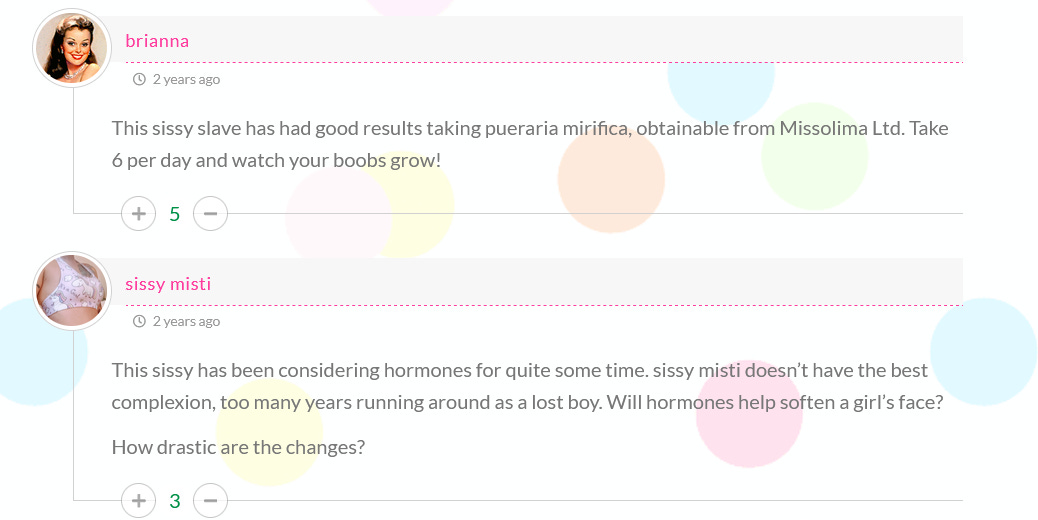
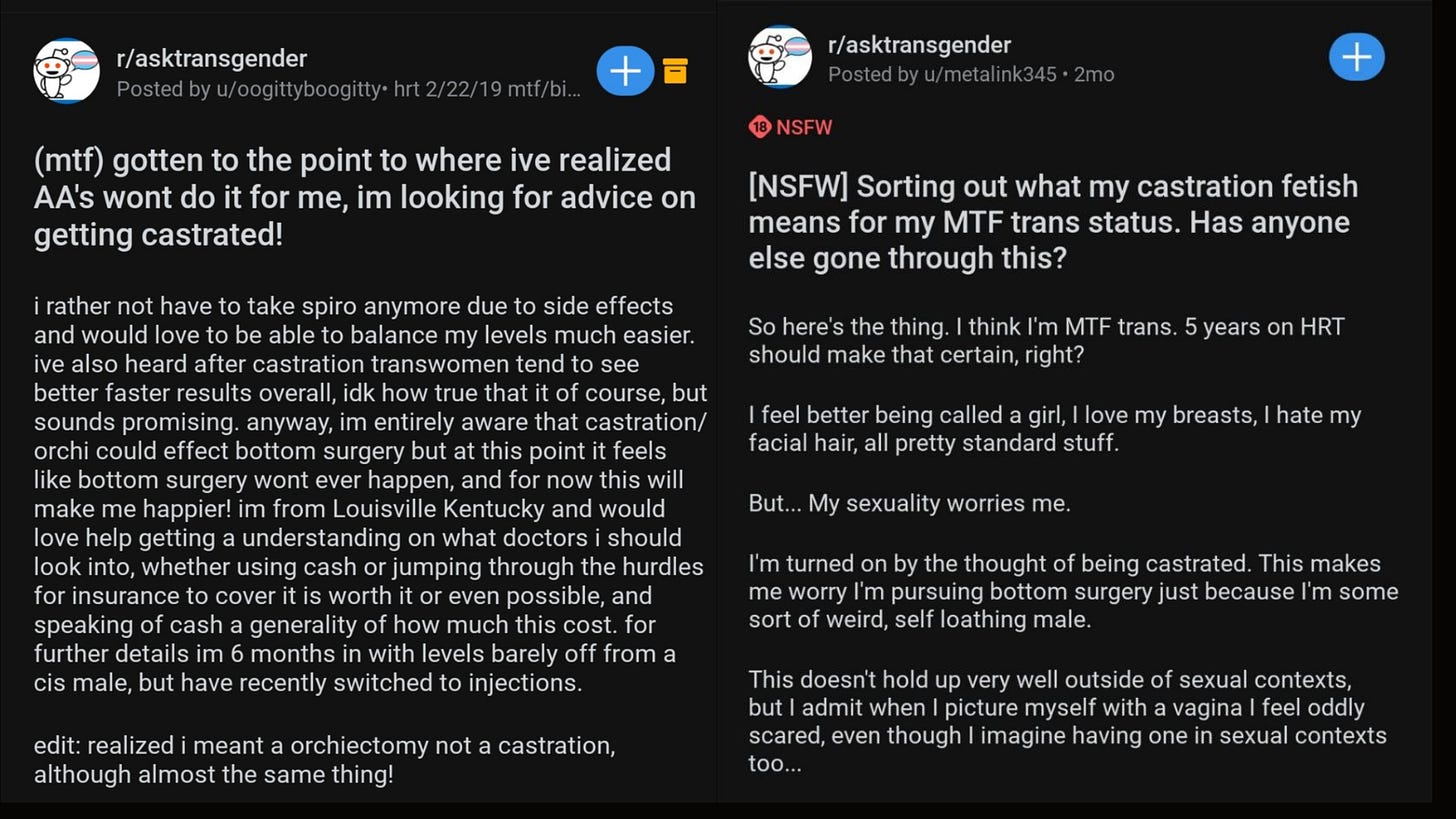
A distillation of the huge body of research you've been sharing with us all this time. A really important read, a thesis that deserves the sort of serious academic consideration one can only dream of in this climate. The gender identity fanatics don't have this - there's nobody writing criticism of this calibre on that side of the ideological divide. Thank you for your amazing work.
Harrowing read, but essential to understand what's been happening in some form for a looong time! These practices existed before porn, but porn has been a destructive tool to further and escalate the evil inflicted on children and women.